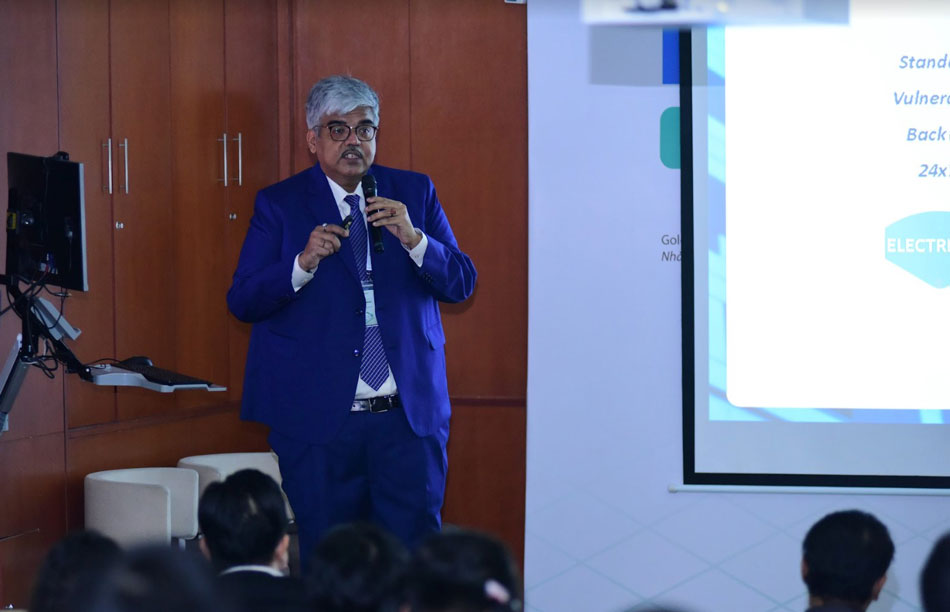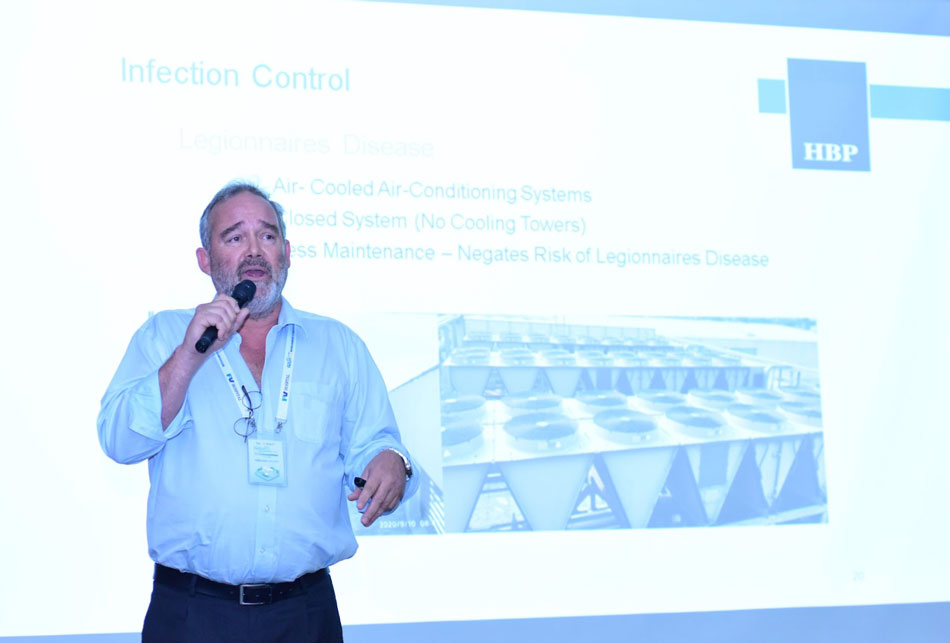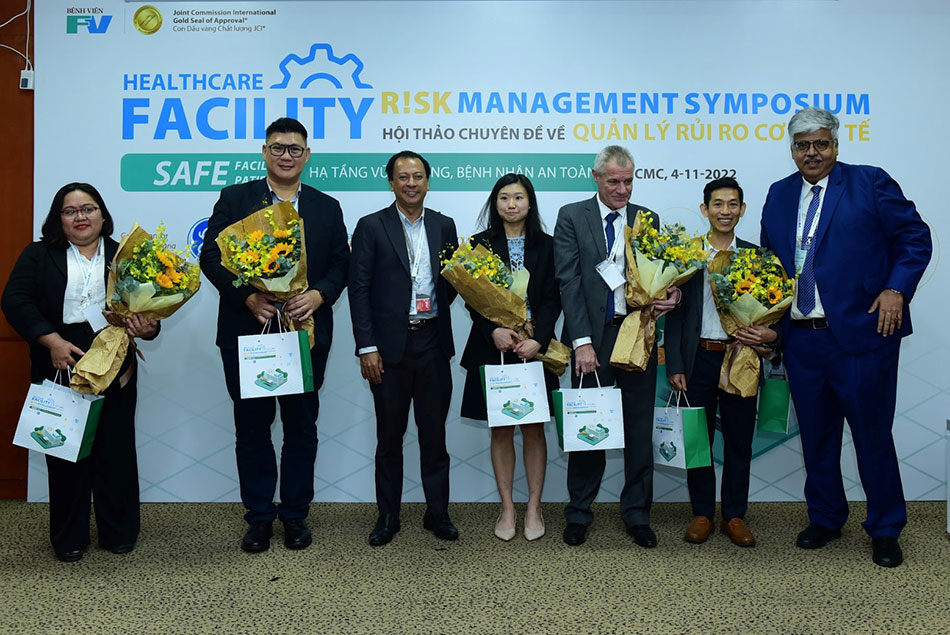On November 4, FV Hospital held the First Symposium on “Healthcare Facility Risk Management” to share experience in healthcare facility risk management in the healthcare sector.
Issues related to risk management of healthcare facility were highlighted and discussed which allows the hospital leaders to have a different perspective about managing a healthcare institution.

Mr Monojit Mitra – Facility and Biomedical Director, FV Hospital, presented Facility Risk Management in a JCI Accredited Hospital
More than 150 people attended the seminar, including Department of Health representatives, hospital representatives from the city, experts and members of the executive board of the FV hospital; representatives of many medical equipment manufacturers in the world, healthcare design consultants and regulatory authority like ECRI.
Usually the patients are unaware of all these activities happening in the background for any healthcare institution, however the impact these incident have on the care processes are humongous and affect the safety and security of the environment in which the care is provided to the patients as well as the effectiveness of the care provided by the clinical team.

Mr Sam W. Stevenson, representative of HBP Project Management – Vietnam, discussed Risk Mitigation through Insightful Building Services Design
The speakers provided information on how to identify and assess healthcare facility risks, as well as the safe operation of a hospital according to JCI standards. Attendees were able to understand the processes used by hospitals like FV in assessing healthcare facility risks in utility management, fire safety management, hazardous materials management, medical equipment management, disaster preparedness and pre-construction risk management; using artificial intelligence to enhance the efficiency of digital imaging solutions and have a glimpse of the inherent risks associated with the management of medical equipment in the hospital.
The symposium was not only useful for health facility managers, but also raised awareness on the importance of healthcare facility risk control in hospitals for the Drs imparting care to the patients in a hospital and the hospital design and consultant professionals. . In particular, the presentation on Hospital Facility Risk management of utility systems, environment and medical technology in a JCI accredited hospital through the experience of FV hospital by Mr. Monojit Mitra – Facility and Biomedical Director was highly regarded, helping representatives of many hospitals see the importance of risk reassessing in their medical facilities.

Flowers were presented to all speakers to show our appreciation
Identifying and controlling risks in a hospital environment
When talking about medical risks, people frequently focus on risks associated with clinical care rather than paying close attention to risks associated with infrastructure—factors that have a considerable impact on patient safety. In his presentation, the representative of FV Hospital emphasized that in order for a medical facility to operate smoothly, it is necessary to identify and control 5 critical utility factors: electricity, water, air conditioning system (HVAC), medical gases and patient movement (lifts and ambulances); understand and manage the risks with medical equipment , identify and train hospital staff to manage risks associated with fire safety, hazardous materials and disaster management. . These are factors that are patient and their families are unware of , but greatly affect the safety of the patient and the environment and the equipment which affects the quality of the treatment provided by the doctors; , hence, it is absolutely necessary to ensure a detailed and thorough implementation of the same.
Typically, the electrical system needs to operate 24/7 across the hospital, supported by the backup generators. In addition, the hospitals have to identify the vulnerable locations across hospitals such as operating rooms, ICU, laboratories, and IT Server rooms, wherein power cannot be stopped at any time and hence will require an uninterrupted power supply unit with battery back up to support all activities in these areas.
Water quality in a healthcare facility is closely related to patient safety. Poor quality water can affect samples, pasteurization, and sterilization of operating room equipment, preparation ofpatient meals, carrying out haemodialysis and dental clinic procedures. Systems have to build and monitored to ensure the right quality of water for all locations, where the need is varied.
According to Mr. Mitra, the air system in the hospital needs to be well controlled in terms of ensuring appropriate pressure, temperature and humidity are maintained across the hospital with proper air exchange rates and filtration systems. The pressure difference ensures proper infection control through the flow of infected air. In addition, medical gas (for example oxygen) should be provided according to the needs of each patient across the hospital. In particular, during the Covid-19 pandemic, the oxygen requirements for the treatment of the affected patients were much higher than the usual and the FV facility team was quick to install a liquid oxygen tank as a backup system to ensure that there is no shortage of oxygen for the patient, during the pandemic and afterwards.
Fire risks in hospitals are many and is of particular concern in all patient care areas with patient who are immobile, e.g. recovering from a surgery. Hence, the facility team need to understand the risks associated with fire risks across the hospitals in storage, evacuation, safety knowledge, signage, extinguishers and work with the staff in providing the right infrastructure and training in ensuring a safe environment.
There must exist a proper medical equipment management program in every hospital which will encompasses steps in the equipment management from need assessment & purchase, installation and commissioning, initial and periodic testing, risk based inventory, preventive maintenance, calibration plan, corrective call management, spare and accessories management, training to users and engineers, managing recalls and discarding along with connections to other equipment and HIS / PER (patient electronic record). According to Mr. Mitra: “Medical devices are meant to save lives, but if they are not operated properly and suddenly fail, it can endanger the life of the patient”. Multiple examples of such life dependent medical equipment are available in the hospital like critical care ventilator, haemodialysis machine, defibrillator, anaesthesia workstation in the OR, ECMO (extracorporeal membrane oxygenation) at ICU, just to name a few.
Hazardous materials are another potential hazard, so the selection and use of materials in a healthcare environment must be as per accepted hospital processes developed following international standards. Mr. Mitra insisted, every hazardous materials used in the hospital must be evaluated for safety features, adverse effect on health, flammability, corrosiveness; special storage and use of appropriate PPE (personal protective equipment); availability of MSDS (material safety data sheet) at all locations, simple and just identification labels for all containers, training to the users on using, storing, action to be taken during minor and major spills of hazardous materials must be completed.
Hospital safety – needs collective awareness and cooperation
Coordination between departments is crucial to manage facility risks in a hospital along with awareness of safe pracices for all staff working in such environment. All staff (including the contractual services like security, housekeeping) at FV take part in routine safety training and tests, and periodic mocks for various drills to assess the readiness of the hospital for all such events.
Additionally, FV staff can always raise an Incident Report on an event, which is not as per the approved processes of the hospital and could pose to patient or staff safety. All such reports are reviewed and processed in consultation with the relevant department to take appropriate steps which enhances operating methods.
At FV, the facility department regularly collects, analyze and evaluate data, make multiple rounds and inspection across the hospital to check on systems , equipment and staff knowledge on safety to identify gaps and risks across the hospital. The team of engineers at the facility department of FV hospital all have the right skill, knowledge and experience to understand every details of the hospital and address any issues promptly to eliminate any potential risks. We are aware that safety is a prerequisite in hospital operation.
“…it is with proper discipline and following all safety guidelines for multiple years, that the facility department have supported the hospital for the third consecutive JCI accreditation, the last one in April 2021.”, shared Mr. Mitra. “We are consistently delivering an environment, safe and secure for the patient and in which the clinical team can provide the care to the patient using the properly maintained and calibrated equipment for the last twenty years…”
The guests highly appreciated the meaning of the symposium “Healthcare Facility Risk Management”, in which, FV’s facility risk management experiences are worth serving as a model for many hospitals to refer to.



